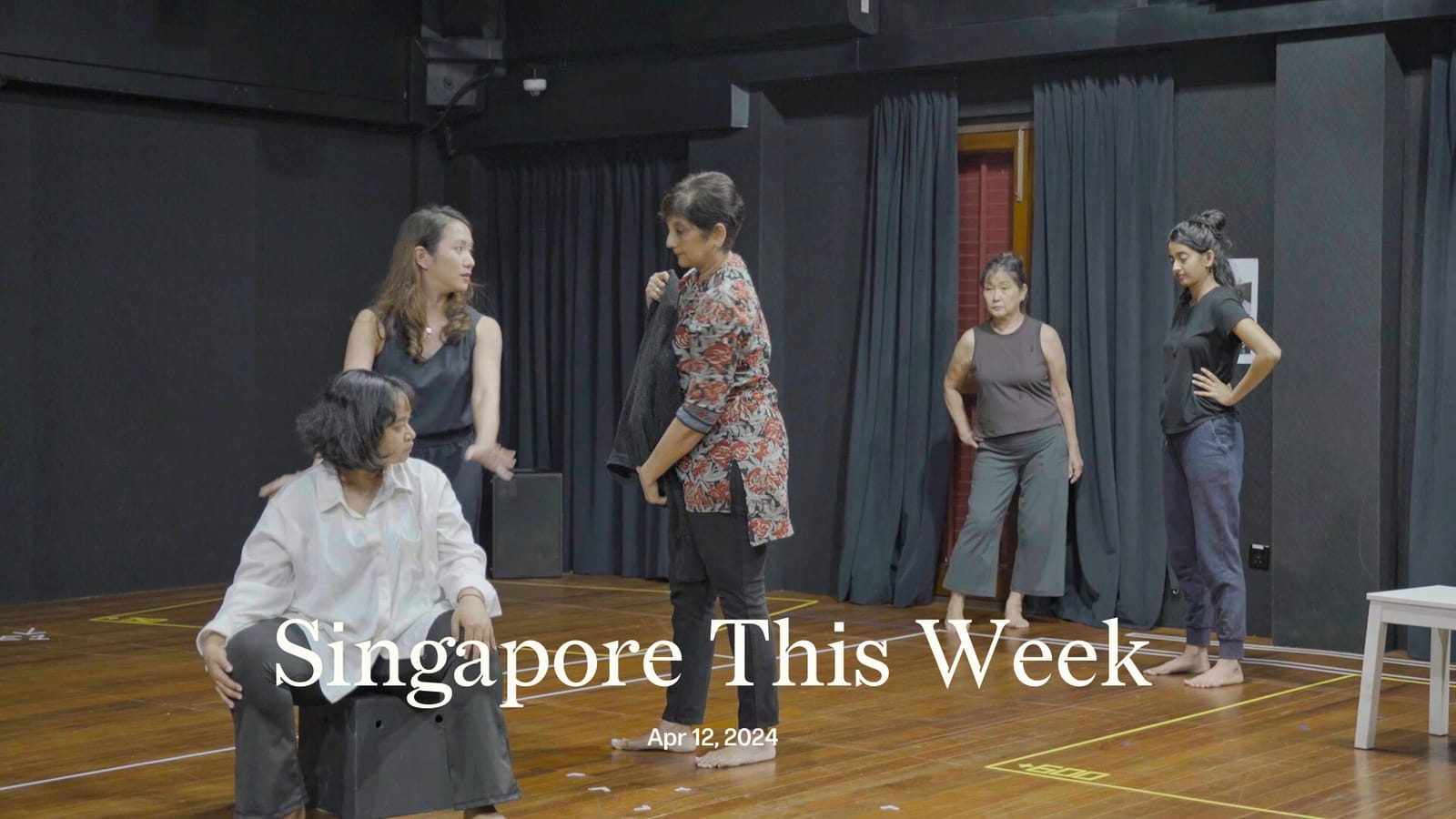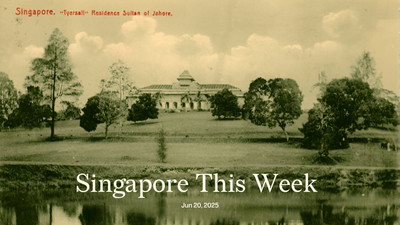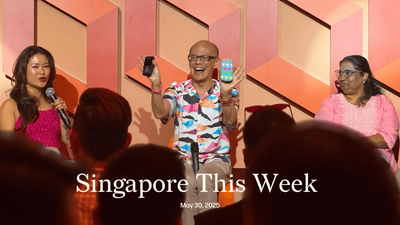Politics: ‘At Singapore Airshow, the Gaza War Was a Selling Point for Israeli Arms Makers’
That was the headline of a recent article by Avi Scharf in Haaretz, Israel’s newspaper of record. Scharf opens by contrasting the presence of Israeli weapon manufacturers at the recent Dubai airshow—vacant booths, “cordoned off by red tape”—with their presence at the Singapore airshow. Here, it was buoyant, with an Israeli pavilion “inaugurated by the Defense Ministry’s director general, the head of Sibat (the ministry's international directorate for defense exports), the ambassador to Singapore and the chairman of Rafael [an Israeli weapons manufacturer]. The pavilion, with its many booths, was centrally located and proved to be a pilgrimage site for numerous foreign delegations.”
Military men from across Asia were gawking at Israeli drones, unmanned aircraft, anti-drone technologies, missiles, and other weaponry that are currently being deployed in Israel’s war on Gaza. Singapore, of course, was the gracious host—providing a space, seemingly, for salespeople to transform the blood of over 30,000 Palestinians into marketing material. And so while we officially call for a ceasefire, we unashamedly support Israel’s military industrial complex. A contradiction? Apparently not for the ruling People’s Action Party (PAP). “The Singapore Airshow is organised by Experia Events Private Limited, which has discretion in the invitation of exhibitors, as long as exhibitors are not subject to prevailing sanctions by the United Nations or the Singapore government,” Gan Kim Yong, minister for trade and industry, said last month.
But of course, we are more than just unquestioning hosts. Scharf also describes the substantial purchases by the Singapore Armed Forces of Israeli arms, including unmanned aircraft and missiles. It’s all very hush hush, he claimed: “...representatives of Israeli weapons manufacturers at the airshow asked ‘not to talk about the local client.’” By ignorantly framing Singapore’s geopolitical predicament as similar to Israel’s—“Israel in a Malay-Muslim sea”, Lee Kuan Yew once quipped—hawks here have effectively helped finance the production of ever-more-sophisticated weaponry in Israel. It’s time Singapore reconsidered its relationship with its old ally. A genuine, open public discourse on what citizens want is a good starting point. The days of wayang with the “Mexicans” are coming to an end.
Some further reading: “Merdeka, Palestine” by Faris Joraimi, our history editor, is the second in a three-part series about Israel’s war on Gaza. Looking back at the last century, Faris shows broadly how Malaya and Palestine were connected by the same global structures of domination, which survive to the present.
Politics: PAP controls PA partly for perceived electoral gain, Inderjit confirms
One of the many oddities with Singapore’s democracy is that even in opposition-led wards, it is a politician from the PAP who serves as the grassroots adviser to the People’s Association (PA), a powerful statutory board under the Ministry of Culture, Community and Youth. The Workers’ Party has long complained about this seeming partisanship. In 2019, Pritam Singh, its chief, spoke about a delay in building an access ramp for those with mobility issues in his ward. “Other proposals by opposition MPs [members of Parliament] for the community are commonly ignored by the People’s Association,” he said. The establishment’s official reason for this link is that the PA’s work is directly connected to the government of the day. “It’s an organisation that helps to explain and implement government policies, so it’s a government thing, and not a party thing. They want to have someone in charge who they can actually work with. That is the official explanation,” said Inderjit Singh, a former PAP MP, in a video interview this week with Viswa Sadasivan, a former nominated MP.
Yet Inderjit, who as backbencher was never afraid to speak his mind, also mentioned the perceived electoral benefits, referencing Lee Kuan Yew’s emphasis on winning elections. Inderjit said that whichever the ruling party is, it will seek to “use whatever agencies and tools they have to gain advantage over the opposition.” Sadasivan had wondered if this strategy is increasingly counter-productive, especially for younger people concerned about justice and fairness. “Whether being in control of PA is going to help us win more votes or less, I think this is something that may change over time,” Inderjit said. “But I think in the PAP, the belief probably still is that that’s an important avenue to reach out to residents and therefore, you know, opportunity for their potential candidates to get support.” Inderjit also shared his thoughts on the PAP’s fourth-generation (4G) leadership, and its prospects ahead of the next general election, which must be called by November 2025. He suggested that the 4G must do a better job of listening to and understanding ground sentiments. “They’re trying their best with all the TikToks, funny things that they do, I think that only is going to address a small section [of voters].”
Politics: Revolving door
The sad decline of The Straits Times (ST) and Singapore Press Holdings (SPH) continues. In 2021, after years of poor performance, SPH spun off its media unit into a non-profit entity, SPH Media. In 2022, the government committed up to S$900m of taxpayer money to the trust. In 2023, SPH Media announced that SPH had been fudging its circulation numbers—some of the shenanigans involved printing copies for customers who never wanted them, and then likely trashing them. This week, the publisher of titles including ST, Lianhe Zaobao, Berita Harian and Tamil Murasu announced that Chan Yeng Kit, a career bureaucrat, will relinquish his role as permanent secretary of the Ministry of Health (MOH) to become its new CEO. Yes, Chan excelled during the Covid-19 pandemic. But, like his SPH predecessors, Teo Lay Lim and Ng Yat Chung, it’s his first-ever job in the industry. He has less media experience than some of Jom’s interns.
It’s shocking for SPH Media to continue this tradition of parachuting in neophytes—Chan will be “seconded to SPH Media”, the Public Service Division proudly announced. Instead, it could have headhunted top honchos from firms, like The New York Times, which have shown that it’s possible to make handsome profits amid digital disruption. While the elites frequently preach about the need for ordinary Singaporeans to benchmark ourselves against the best in the world, and to be open to competition from overseas, these appointments suggest that there are numerous jobs that are protected and reserved for chums. They can pay well over a million dollars a year—what Ng previously earned, and what permanent secretaries like Chan typically get. (SPH Media did not respond to confirm his salary.) It’s outrageous that industry newbies at a floundering, taxpayer-supported “non-profit” earn more than seasoned media executives at successful, for-profit firms globally. Perhaps, from the establishment’s perspective, Chan’s lack of industry experience is less important than his nine years as chairman of the Infocomm Media Development Authority (IMDA), the country’s main censorship body. He probably has a keen sense for what Singaporeans’ delicate ears should—and shouldn’t—hear.
Society: Waste not, want not
Have you ever wondered what happens to the leftover gu lou yok and nasi goreng at hotel buffets? More often than not, it’s unfortunately thrown away. Afraid of being held liable for any possible food safety issues, most food businesses would rather err on the side of caution and throw out leftovers instead of donating them. Louis Ng, PAP MP and founder of animal welfare group ACRES (Animal Concerns Research and Education Society), spent the last four years developing a new Private Member’s Bill to tackle these liability anxieties. If passed, the Good Samaritan Food Donations Bill would safeguard businesses from illness or injury that may arise from the person consuming donated food, given these four conditions are met: the food is considered “safe” and “suitable” for consumption when it left the possession of the food donor; the recipient of the food is informed of the handling requirements to maintain the safety of its consumption; the food donor informs the recipient of the time limit for consumption; and when handling food, the donor “took all reasonably practicable measures to comply” with the requirements under food safety and food hygiene laws.
This new Bill comes at an opportune moment, as Singapore’s food waste problem worsens alongside an increase in food insecurity. In the last decade, our food waste has increased by almost 30 percent. In 2022 alone, Singapore generated 813,000 tonnes of food waste, equivalent to 137kg per person. At the same time, moderate or severe food insecurity (which can be understood as insufficient, irregular access to safe and nutritious food) stood at 6.6 percent of the population in 2020-22, an increase from 2.8 percent in 2014-16. While the proposed Bill signals a step in the right direction, some food charities are concerned about receiving large quantities of low-quality food. “We are looking for quality food donations, good donations that beneficiaries can benefit from,” Sim Bee Hia, then chief executive of Food from the Heart and member of the review committee set up for this Bill, told ST in 2021. Malaysia’s own Food Donors Protection Act came into effect in 2020, but it still continues to struggle with staggering numbers of food waste. If the Good Samaritan Food Donations Bill is passed, Singapore will also require cultural, structural, and logistical changes in the food industry for us to see a significant decrease in food waste.
Society: If tooth be told
It has the makings of a Roald Dahl tale—suspense, tension, desperation, sharp tools, macabre humour and human vanity. Except, it’s not fiction. Unable to visit her dentist during the pandemic lockdowns, Siti Shahrima Abd Rahim, a part-time waitress in Johor Bahru, learnt how to perform dental procedures on her braces, using DIY instructional videos on YouTube. When borders reopened, she started advertising her illegal services on Carousell, such as teeth and veneer whitening, veneer application, braces maintenance and retainer fitting, to potential customers in Singapore. She charged S$650-700 for procedures executed in hotel rooms at clandestine locations here. Siti’s ruse went undetected for about one-and-half-years, during which she treated over 30 customers.
That is until February 2022, when a disgruntled customer lodged a complaint with MOH: she could no longer floss as there wasn’t any space between her teeth after Siti had applied veneers on them. A district court fined Siti S$2,500 on April 8th, after she pleaded guilty to one count under the Dental Registration Act. A dental expert’s report noted that Siti’s actions could have resulted in the customer requiring more complex procedures. That dental fear and anxiety is prevalent among roughly 15.3 percent of adults worldwide—more so among women—it’s curious that people would instead trust a freewheeling “dentist” to treat them without the proper equipment. Perhaps Siti’s prices, significantly lower than the rates of qualified medical practitioners, were worth the risks? In this day and age of the mid-career switch, so enthusiastically encouraged by the government, some netizens were impressed by the quack dentist’s entrepreneurial spirit and admired her for having “taught herself something” that would typically take eight years. But reskilling has its limits. Given the record number of scam cases here, if you hear of dental treatments that are unbelievably cheap, it may be prudent to simply keep both wallets and mouths closed.
History weekly by Faris Joraimi
I touched briefly on the uneasy concept of “heritage” last week. But as I scrolled down my Facebook wall, I realised just how much I’ve been enjoying a community page called “Heritage SG Memories”. Its active users post daily images with accompanying captions that recall a place, a time, an object or regular event that was once commonplace or existed in Singapore. Disappearance, to time and change, is what unites subjects as diverse as the Van Kleef Aquarium, Singer sewing machines, bulky Sony hi-fi systems, a Japanese street cobbler in Yishun, and opeh leaves that once wrapped Hokkien mee. It’s remarkable what people’s memories and biographies unearth—how many books will show you the inside of an Ang Mo Kio flat in 1992? Warm, convivial and guilt-free nostalgia flows in the comment sections, making this page really special: people are actually kind to one another. Maybe it’s my algorithm’s fault, but many history-based regional community pages I’ve followed drown in mean and corrosive ideological debates: who owns rendang, whether Malays were also migrants to Malaysia, or if Muslim women used to be more “free” because they didn’t wear tudungs in old photos. I already have to engage controversial topics through books and research, so I’d rather have more wholesome content on my screen if I can help it; there’s plenty of urgent current affairs more deserving of our internet bandwidth.
Heritage SG Memories recalls the past differently from official archives: ordinary folks volunteer their detailed testimonies, producing an intimate archive that’s open to collective engagement, contribution and response. Many posts capture the sound or smell of a memory: one image showed a “HDB flat in early days”, windows crammed with laundry hanging from bamboo poles. “Imagine the chaos,” read the caption, “if someone shouted ‘LOR HOR LIAO, SUDAH HUJAN’”. Cue the pitter-patter of raindrops. Lost knowledge is kept in these friendly vignettes. One Robert Chia posted a treatise on kite-fighting, identifying the names of different designs, how each was made, before the pitched aerial battle and victory: “‘Anyut, anyut’ (Malay for “Cut, cut!”) goes the triumphant cry as one of the combatant’s line is cut and the kite detached from the thread-line that only moments ago held it proud and taut in the evening breeze.”
Arts: A trip through the theatres of tomorrow
“Tomorrow, and tomorrow, and tomorrow”: so begins the famous Macbeth soliloquy, where the titular character reflects on a moment of mortality close to the end of the play. It’s one of Shakespeare’s most quoted passages on the parallels between stage life and real life: “Life’s but a walking shadow, a poor player,/That struts and frets his hour upon the stage,/And then is heard no more.” In that spirit, “Tomorrow and tomorrow” is also the title of a freshly launched showcase of works-in-progress by Singaporean theatre groups at this year’s Singapore International Festival of Arts. These temporal coming-togethers—the brevity of that shared hour in the theatre and our broader shared time on earth—thread through 12 hour-long pieces presented by the likes of Drama Box, Teater Ekamatra, Nine Years Theatre and The Necessary Stage. Here, they get to work through early sketches of performances and possibilities around future programming. The Theatre Practice’s “Performing The Director’s Notes: All The World’s A Sea” features intimate correspondences between director Kuo Jian Hong and her beloved late father, Kuo Pao Kun, whose pioneering work in theatre and performance gave rise to institutions and independent spaces that have nurtured generations of artists, including the Intercultural Theatre Institute and The Substation. An epistolary exchange from 1989 reveals the theatrical and familial inheritances of one of the country’s most illustrious performing arts families: “Dad, how’s the script? (I mean, have you started?) I have some ideas for set and lighting already! Watch your health and don’t eat too much. Mama says you’re getting fat.” “Miles” by multidisciplinary artist inch Chua promises a very different kind of intimacy, an “anti-musical” featuring a soulmate generated by artificial intelligence (AI), a companion for the digital age.
These ruminations on relationships, mortality and time also take the stage in Esplanade’s TRIP, another upcoming showcase platform dedicated to the work of early-career directors in Singapore. It’s a women-centred season fronted by young theatre artists Sim Yan Ying “YY” and Renee Yeong. Sim kicks off the showcase this weekend with the devised piece “pass·ages”, an interdisciplinary and intergenerational work bearing witness to four women at very different stages of their lives, each grappling with metronomic milestones such as dementia, menopause, and puberty. It’s in the iterative and labour-intensive processes of creative work—creeping in their “petty pace from day to day”—through which these artistic explorations and ambitions might see a tomorrow.
Arts: Artistic leadership in Singapore? Ada.
Thought leadership. The Global South. Decoloniality. Intersectionality. Knowledge production. All crucial concepts turned sexy buzzwords now regularly deployed in arts programming around the world. It can be hard to distinguish what’s thoughtful from what’s token, especially in a landscape populated with ivory towers, champagne socialists, and gatekeepers looking to parade the next young artist with an on-trend pedigree. T:>Works artistic director Ong Keng Sen has always had a knack for collecting and curating artists at just the right time—before their meteoric rise and subsequent hypervisibility makes them impossible to schedule into a festival or circuit. He’s also made an art of the architecture of creative networks, experimenting with permutations of practitioners that may initially surprise but eventually make sense. T:>Works’ upcoming edition of the Per°Form Open Academy of Arts and Activations (POA) continues the company and its director’s long lineage of curating intellectual and artistic gatherings going back to the 1990s. Its eclectic lineup of 15 Fellows from Africa, the Arab world, Asia and South America will offer talks, workshops and experiences throughout April. The Academy kicks off with a rave, continues with a marathon series of presentations running from noon till past midnight (capped off with a communal feast), and spans a whole gamut of disciplines from fashion to film and spoken word. It’s a rare chance here to hear from pioneering practices as farflung as Bogotá and Lagos—and also to think more broadly about artistic leadership in each of these contexts.
Discussions around arts leadership in Singapore can be fraught, as companies look uneasily to a future beyond their often totemic founders. “Pao Kun died in his 60s. Mortality is something that you need to prepare for, inevitably. And I don’t want succession to be an inevitable measure, when you can’t help it,” said Chong Tze Chien, former company director of The Finger Players, about the impending mortality of a generation of artists and cultural leaders, in an interview with ArtsEquator. T:>Works has an ongoing open call for their Artistic Directors Academy (ADA), a natural follow-up to POA. The company recently hosted a panel on “The People Cultures of a National Theatre” in the hopes of revving up public discourse around the topic. Lest we forget, the art world is also rife with power differentials and asymmetries. Yet such efforts will, hopefully, avert the kind of dynastic, triple-portfolio, parachuting game of musical chairs we see so often in other realms of the city state.
Business: The Singapore glow
A Singaporean brand, Allies of Skin, is making a big push into the US male skincare market. After recording a positive EBITDA (earnings before interest, taxes, depreciation and amortisation) in 2023, it has just raised US$20m (S$27m) from Meaningful Partners. The firm’s first institutional funding follows previous investments from individuals such as celebrity Henry Golding. Founded in 2016 by Nicolas Travis, Allies of Skin started with the 1A all day mask product, which achieved S$700,000 in sales in its first year. The company initially launched in new markets through retail partners such as Sephora, Space NK (US), Nordstrom, Anthropologie and Bloomingdales.com, and major e-tailers such as Net-A-Porter, Mr Porter and Barneys. Since 2020, however, it has shifted its focus to direct-to-consumer sales, which contributed 35 percent of overall revenue in 2021, up from 20 percent in 2020. The US represents the largest beauty and personal care market globally, with projections from Statista indicating a potential market size of US$115bn (S$155.5bn) by 2028, up from just US$80bn (S$108.2bn) in 2022. Other Singaporean brands such as Love Bonito, Skin Inc and Re:erth are also eager to capture a share of the US’s expansive market. Despite potential challenges in profitability due to scaling efforts involving paid media and influencers, as outlined by Travis, Allies of Skin is poised with a “solid plan” for sustainable business growth. Its foothold in the US, strengthened through usage by celebrities such as Simu Liu, alongside its strong international presence in 36 countries through 40 retail partners, suggest that Allies of Skin may be able to deliver to investors the same “radiant results” it promises its customers.
Tech: Bright spots in a gloomy tech job market
Last year, Singapore’s tech sector mirrored the global tech downturn with numerous layoffs at firms such as Lazada, Amazon and Grab, amongst others. In addition, salaries generally declined. Yet roles in data science, cybersecurity, and other specialised fields bucked this trend, registering significant wage increases. This divergence underscores a shifting demand within the tech industry, where expertise in burgeoning areas like generative AI and cybersecurity have become more valuable than ever. Tech recruiting firm Nodeflair’s latest report highlights this trend based on an extensive pool of over 422,000 salary data points, providing a broad and detailed snapshot of the current salary landscape. Data scientists led the pack with an 11.3 percent wage increase, likely driven by the AI boom prompted by technologies like ChatGPT. This has prompted, per the report, investments in talent capable of advancing AI technologies, which is also in keeping with Singapore’s updated AI strategy aimed at economic enhancement through AI integration. Meanwhile, the rise in cybersecurity engineers’ salaries by 8.24 percent echoes the growing cyber threats in Asia Pacific, marking the region’s response to being the third-most targeted by cyberattacks in 2023. This rise signifies an elevated prioritising of cybersecurity infrastructure, reflecting a broader global trend towards enhanced digital protection. Conversely, the overall drop in tech salaries can be attributed to a decrease in start-up funding—38 percent down in Asia, said Nodeflair—amid global economic uncertainties. The result: widespread layoffs and a cautious approach to hiring and compensation across the sector. In 2024, expect a continued emphasis on specialised roles in AI and cybersecurity, amidst strategies to navigate the talent crunch and financial challenges through cross-border and remote hiring practices.
If you enjoy Jom’s work, do get a paid subscription today to support independent journalism in Singapore.
Correction: an earlier version of our SPH blurb read, “In 2023, SPH Media announced that it had been fudging its circulation numbers...” This has been updated to the current, “In 2023, SPH Media announced that SPH had been fudging its circulation numbers...”








